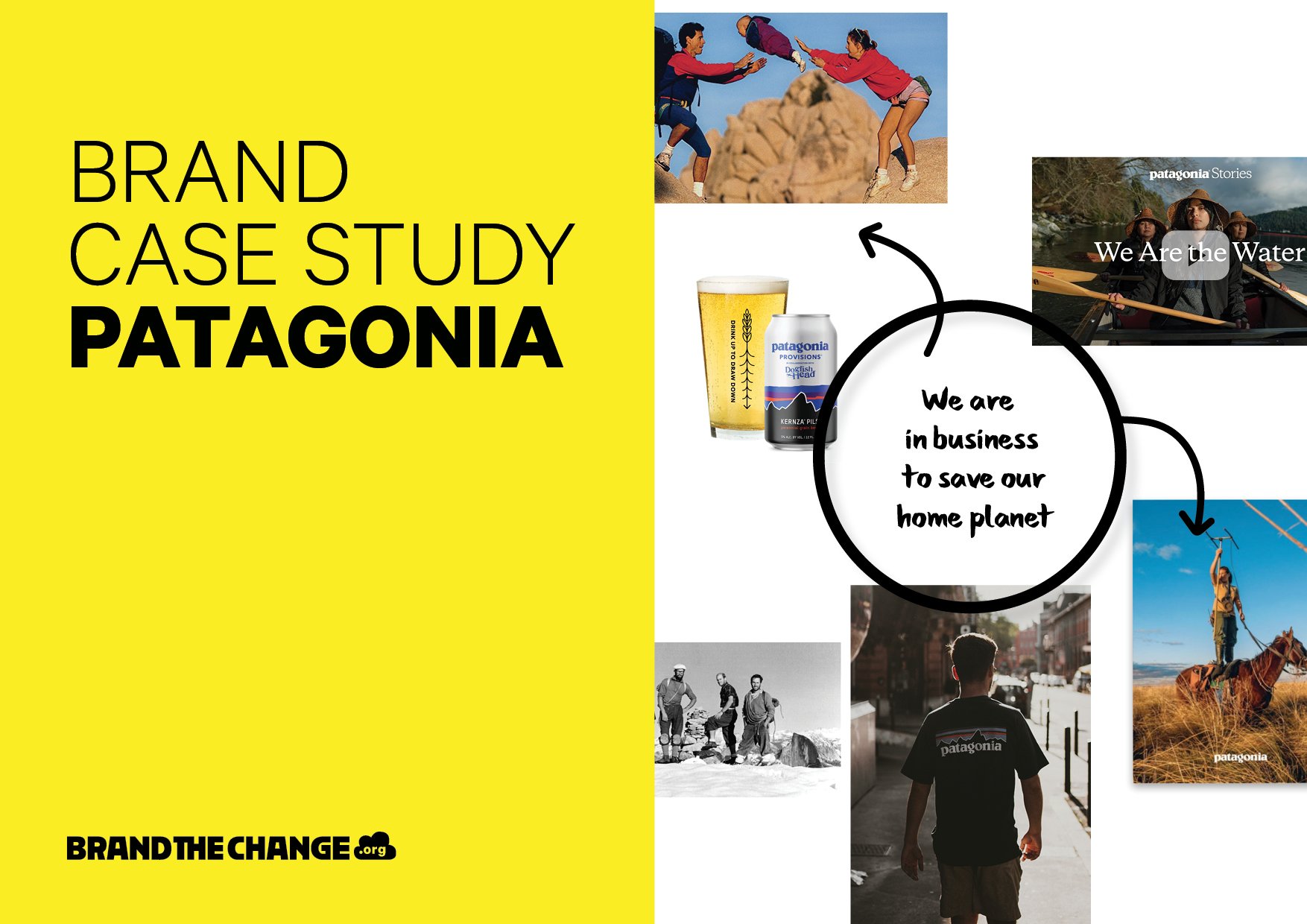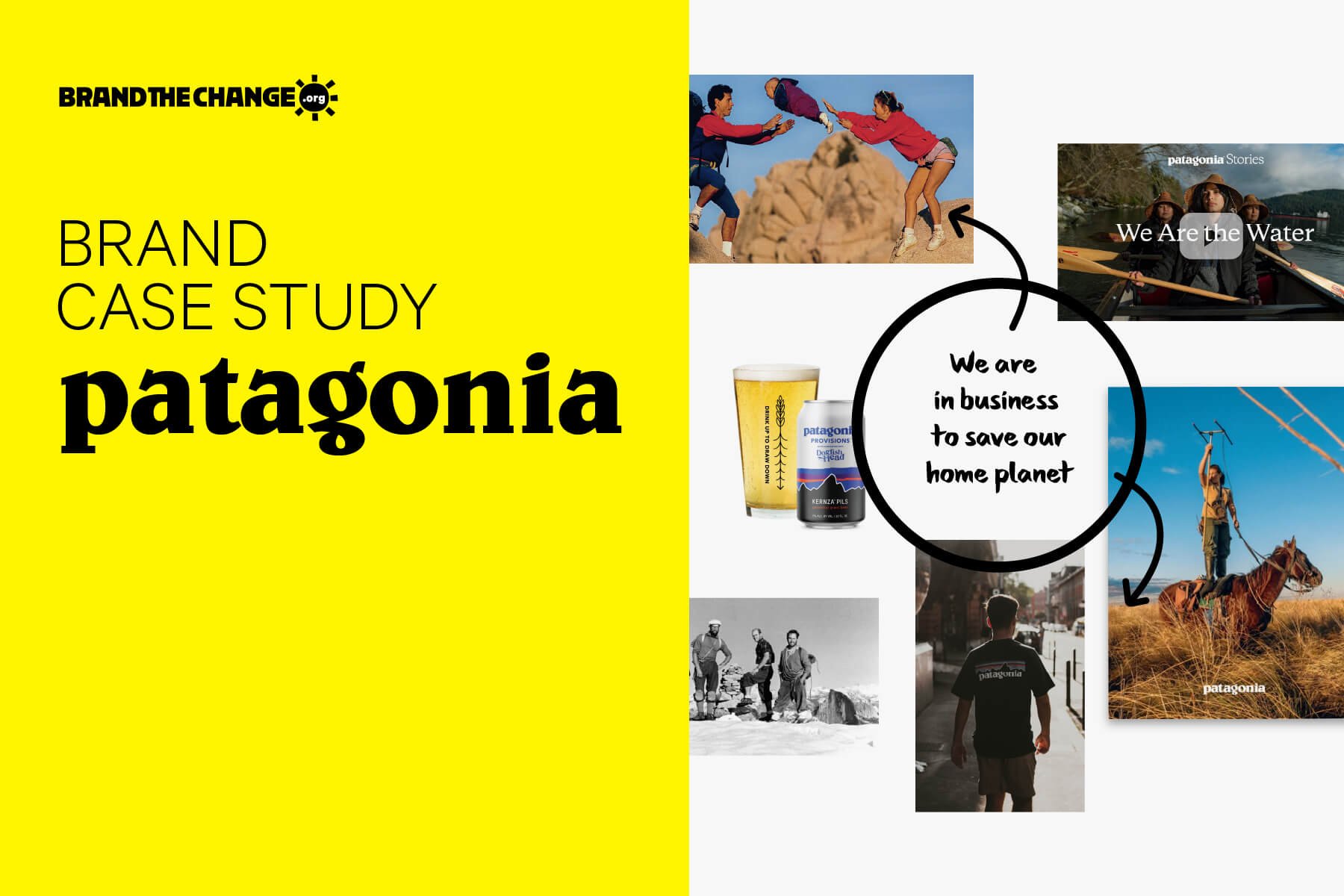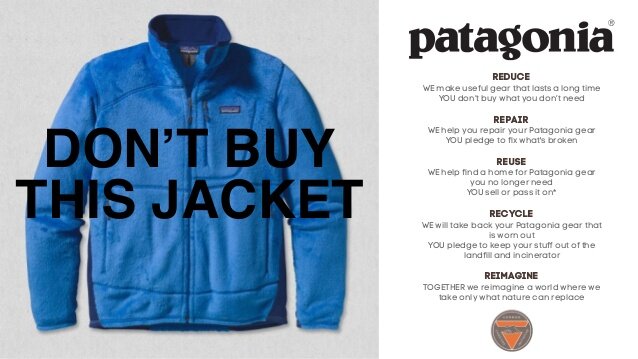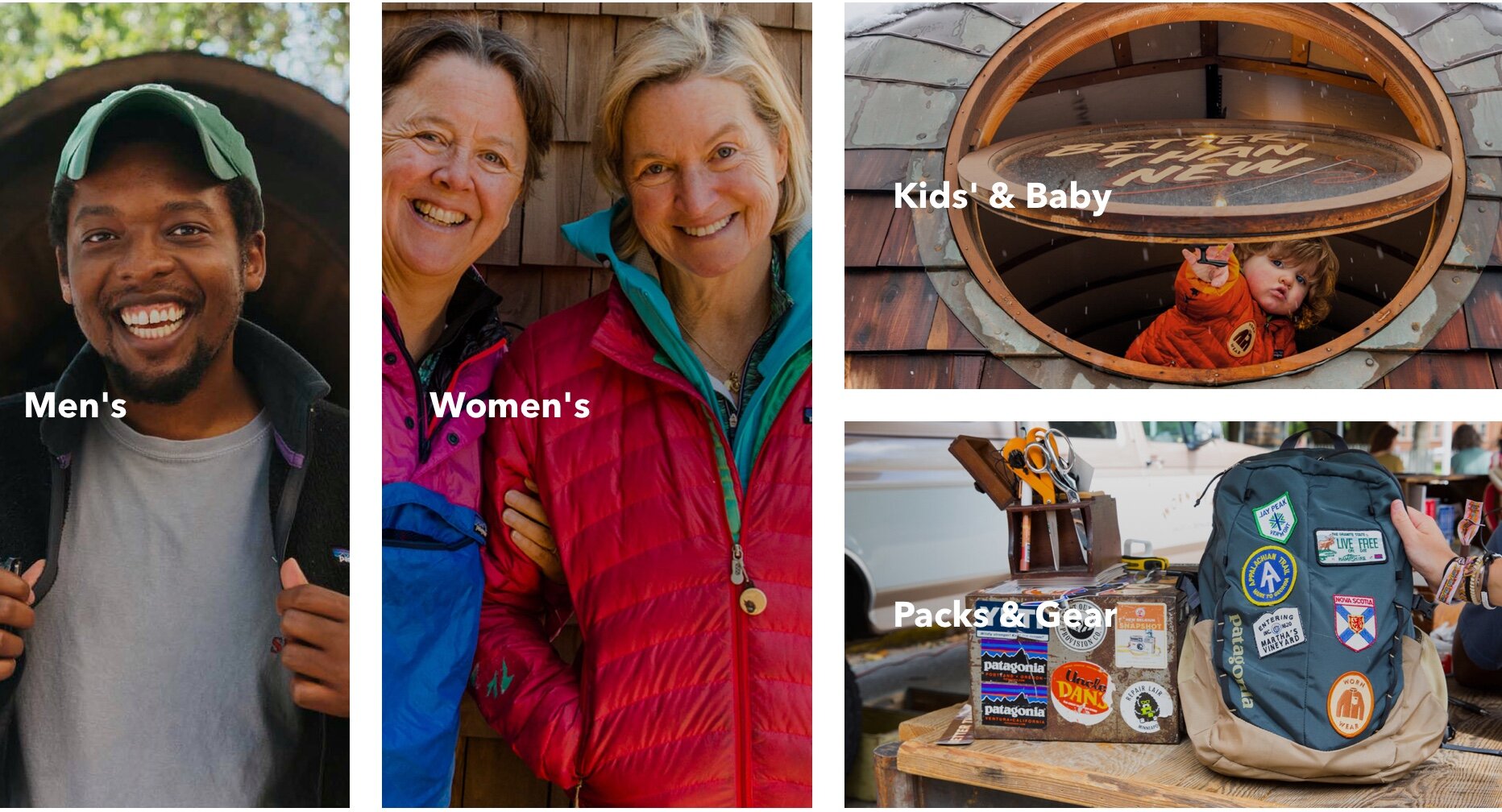The Brand Story of Patagonia
Patagonia has grown to be one of the most recognizable brands in the world. Discover how a fifty-year-old brand can maintain its identity and thrive through rapid growth, shifting trends, and a raging climate crisis. Alex Weller, Director of Marketing at Patagonia Europe, spoke at Brand The Change Live in Amsterdam in 2018. He shares the company’s story from its humble beginnings, to how the team discovered their real purpose and how they are only now, at fifty years old, hitting their real stride.
The article below is a transcript of that talk.
Are you looking for the full brand case study of patagonia?
Get your copy from our resources section. The 24-page case study (PDF) contains:
the 50+ year evolution of the brand
the philosophical foundation that guides all action
the Patagonia brand strategy on a page
an analysis of the brand expression from visual to verbal identity
an analysis of the translation of the brand purpose to all experiences
WHY IS PATAGONIA So popular right now?
Alex Weller: “I'm gonna start with a little personal anecdote. Last Winter, me and a group of cyclists, mates from here in Amsterdam, decided to ride our bikes from here, this office, to COP23 in Bonn. It was in November and it's 320 kilometers so it takes quite some time, and it was raining most of the time. You do have quite some time to talk, and one specific conversation I was having with a guy who until that point I didn't know so well. He asked me quite simply, "Why do you think there is so much interest in Patagonia right now?" My instinct wasn't to talk about what we've been doing. My response was actually about hope.
“In what feels like an increasingly stormy and chaotic world, people are looking for little anchors of hope. ”
They're finding them in new and interesting places. In small grassroots groups, environmental groups, NGOs, and people with loud voices. Also brands, interestingly enough. It's Patagonia the activist company that people seem to be increasingly gravitating towards. That, I think, is a simple answer to the question.
The fast fashion industry has become one of the most wasteful consumer industries in the world.
The context for that, and there will be some levity in here but it's a little dark moment, is the environmental crisis. A crisis that is caused by the business that we do, in some sense. The massive over-consumption of clothing. I think people understand that and certainly the culture creatives understand that. Or, as we call them, eco-progressives. They understand that.
They're no longer asking, "Is this thing happening? Tell me more about it." They're saying, "What can I do, how can I take action?" That desire to take action is pointing people toward the platforms that are offering them ways to take action with their money, and that's where brands come in.
what’s the story of the patagonia brand?
AW: Patagonia hasn't always been an activist company. In fact, in 1968 when our founder Yvon Chouinard made a trip with a few buddies from California down to Patagonia, Chile, to climb this mountain, Mount Fitz Roy, there wasn't really such a thing as environmental activism and there certainly wasn't an idea that brands or business could participate in social change and positive environmental impact.
From going on that trip, the company was formed. That trip, that skyline, in a very literal sense created Patagonia. The Fitz Roy skyline, the name of the company, what we make. High-quality, technical outdoor gear for climbing and activism as it was then in its early days.
The Mount Fitz Roy skyline that inspired Patagonia founder, Yvon Chouinard, and became part of the brand’s logo.
It was a short time after in 1973 when YC, as we sometimes call him, and his mates started the company and started this process of discovery. One of the first big discoveries that they made was making stuff is really damaging.
This was primarily brought to their attention because the first stuff that they were making were cotton. When the climbing guys went out to the cotton fields, what they immediately recognized is the people farming the cotton were wearing hazmat suits, they recognized it must be toxic. They did a little bit of digging, they realized that lots of people were dying from terrible diseases from farming cotton.
is Patagonia actually sustainable?
AW: This was the moment of realization. This was the kind of aha moment that what he had set out to do with positive intention was fundamentally damaging. This just went against his values and who he was. The journey began, and that journey really was ongoing and has been an ongoing process of self-inspection and course correction.
Cleaning up your own act when you have a complex business model, and a really deep supply chain, is a very hard thing to do, right? We don't refer to ourselves as a sustainable company. I don't think there is such a thing in actual fact, as a company that has a net positive impact on the environment and society.
There is such a thing as a responsible company. That is how we refer to ourselves, and the journey of responsibility that began in 1973 with the founding of the company, stepped through a series of moments of course correction. Big pivots within the business enabled us to address some of the questions, and some of the challenges that we felt we needed to deal with.
Up until about 2011, Patagonia was very, very steady. Tick tick tick tick tick growth. The company has never been really focused on growth. Privately owned. Really, it remained focused on making great stuff and reducing our impact, right? Having values, and being an advocate for those values.
Around 2011, a couple of things started to happen.
“There was an increasing sense of frustration from the company ownership that people just weren’t hearing it. They just weren’t getting it. We started to do some more provocative things.”
One of those quite famous provocative things is an advertisement called "Don't Buy This Jacket." I see a few heads nodding. I'm not gonna go into that too much. It's a little reference to a little bit later in the presentation. Around this time I think something more significant happened. It was a shifting consumer landscape. It was a wider recognition of depressing issues that are facing our planet, our societies, and our communities. The communities that we serve, and their needs were changing and they were actually converging with the values that we've held for a long time. This moment of convergence was a really powerful moment in recent Patagonia history.
Creating a movement
AW: The question you have to ask yourself when you see that happening is what do we do with it? What do we do about the recognition that more and more people are coming to us?
Are we gonna keep just telling them that we're cleaning up our own act and our supply chain is improving or are we gonna take that opportunity to do something more significant?
For us, that became about the recognition that we had an opportunity to build a movement around the brand. A movement that had to be built on action and the opportunity to create an action-based movement with our customer community to have a greater impact than our values.
The Patagonia mission statement leads all aspects of the business
AW: The lens through which we navigate that opportunity, that opportunity to build a global movement of like-minded people in defense of the planet, is our mission statement. It was actually written in 1991, so quite some time ago, but it continues to be the single tool that we use every single day, in every aspect of our business. If we can't square off an idea or an initiative, a new product, or a marketing concept with this, then it doesn't happen. It's also a really powerful tool for alignment. It really sharpens decision-making. It gets you to that full stop much more quickly and effectively.
The outcome of that is because we all know what this thing is and what it means, the ability and the confidence to be quick, to be bold, to take risks, is there as well. I will step you through the mission statement and hopefully give you some insight. I've sort of focused on marketing and communication aspects because that's what we're all here to talk about, I think, and just how that works. How it works for us in a practical sense.
In terms of building the best product, this is the core philosophy within the business: We make products, it's what we do, and one of the most responsible things we can do as a company is to make a very high-quality product that is built to last, is built to be repaired. The single most impactful thing anything, any one of us can do as consumers of garments is just to keep them in use for longer. That practical reality of just having stuff that will last for longer sits at the core of many things we do.
Dylan Thompson, Patagonia Alpine Climbing brand ambassador.
Big wave surfers like Roman Navarro rely on well performing gear, yet wetsuits are the definition of un-sustainable products.
AW: There's also another reality with product quality, as you can see here. This chap's called Dylan Thompson, he's one of our Alpine Climbing ambassadors. It's a matter of life and death when you are pursuing sports at this level, right? Again, that sits right back into who we are and why we exist. This man, Ramon Navarro, who's one of the biggest big wave surfers in the world, he's here wearing a wetsuit. For him this wetsuit is the tool of his trade, right? His surfboard and his wetsuit enable him to do his job. It has to perform, it can't fail him.
Within this picture lies the dark secret of the surf industry. That's a product with neoprene, and neoprene is nasty stuff. It's black stuff, it's extractive, it starts life under the ground, it comes out as oil, it's turned into a synthetic polymer. It uses tons of energy in the process of doing all of that. It is unrecyclable. It is the definition of a non-sustainable product. For Patagonia getting into the surf business and into the business of making wetsuits, came with one precondition that we would get the surf industry out of neoprene.
marketing as an awareness tool
AW: That's where the second part of the mission statement comes in: Causing no unnecessary harm. Which is a really awkward sentence. It sounds sort of intentionally avoiding committing to saying cause no harm, which is what people want it to say. Of course, it can't say we cause no harm. Because it's impossible to cause no harm when you're making stuff. You can cause the least amount of harm. In the wetsuit story knowing that we had to get out of neoprene meant that we had to crack a code that no one was even looking at. Nobody in the surf industry, the communities of surfers around the world, the surf media was saying, "We really need to get rid of this neoprene stuff. It sucks."
Nobody was asking that question and so we had to start from ground zero and go on a 10 year R&D process to work out how to make high-quality performance wetsuits out of natural rubber. Out of a material that we can grow in a renewable way, rather than material that we have to extract in a nonrenewable way. We succeeded, and in 2016 we flipped our entire wetsuit line from neoprene to a new and exciting rubber alternative called Yulex. It was an industry first. The moment that we had cracked that code, we made that code available to the entire surf industry.
[Update 2024: Patagonia has rolled out the first-ever Wetsuit Recyclability Program]
Patagonia Changes the paradigm of communication
AW: Coming back to the point about how you scale great ideas, the best way you can scale great ideas is by giving them away. That remains a fundamental part of how we think about innovation, certainly with a product.
“Another really cool outcome of changing the paradigm so radically in an industry like surfing is that we get to change the paradigm of communication. ”
The standard form of communication for the surfers in the room in the surf industry is to show people surfing radical waves, and it's just the wallpaper of surfing.
To be able to run a print ad in a surf magazine talking to surfers in our community of surfers about why we changed the paradigm and how we did it is pretty radical. Really disruptive and really successful. The last half of the mission statement, and I'm going to go into a little more detail on this one I think because I think there are a few more case studies that you guys are gonna find interesting. It's another sort of long and quite unwieldy sentence. The simple idea is to use the business as a tool for good. Both to inspire others but also to implement solutions ourselves in the environmental crisis.
One of the things that we're really focused on within that context is aiding and educating civil society to be more able to make a positive environmental impact. One of the tools that we use for that is a platform called Worn Wear, and Worn Wear is a clothing repair platform. It's quite simple. It actually started out life as this. It started out life as Don't Buy This Jacket, that was really the very first iteration of Worn Wear.
An example of how Patagonia turned their philosophy into action
To explain that a little bit, Don't Buy This Jacket was not supposed to be a counter-intuitive marketing ploy to get people to pay attention to Patagonia. Don't Buy This Jacket is actually a really literal statement. It means don't buy this jacket if you don't need it.
The most impactful thing that you can do is to question yourself. Do I really need this jacket? Do I just want something in another color? Can I repair what I already have? If you answer those questions, then maybe you do need a jacket and if you do need a jacket, make sure you buy one that's built to last, that can be repaired, etc, etc. A fundamental part of that philosophy is garment care. It's about this idea of not being a consumer, but actually being a custodian of the things you own. The way to be a custodian of the things you own is to know how to look after it, to know how to repair it.
Patagonia launches wornwear
AW: It was a very simple idea and really, probably one of the easiest and most natural things that we were able to do was to take that philosophy and turn it into action. We know how to build clothes, and we've got lots of knowledge. We know how to repair them, and we have repair facilities with incredibly talented seamstresses. And we have the ability to put those people in a van and send them out on the road and repair people's clothes and repair people's clothes for free. Get them excited about the idea of looking after their clothes.
“People love their gear and they love to talk about the experiences that they've had in them.” - Alex Weller, Patagonia.
We started the journey of Worn Wear, and for us here in Europe that was in 2015. From the moment that we launched Worn Wear, we've been out on the road repair pretty much every day ever since. This year I think we've done about 250 repair events, we have three vehicles that are on the road all the time. We repair any brand. It's not a seasonal marketing campaign, it is a physical expression of the core business philosophy.
Something else really exciting happens when you're out on the road every day. You just meet lots of people. People come and they sit down and it takes a little while to have your gear repaired, and they hang out and they chat to our seamstresses, and they chat to us. What you realize is that people just love their gear and they love to talk about the experiences that they've had in their gear. These are really powerful exchanges of knowledge and ideas. We started to learn to capture those stories. Firstly with Polaroids and notes and we started to just build a little catalog.
This guy's Joe, he's a skier. He had shredded his jacket and told us the story of that, and in telling us the story of that he told us the story of his life. Just really cool, interesting stuff. As we progressed, we learned that some of these stories were so good that we wanted to go back and grab them and tell them in more detail and share those stories back to our communities. I'm just gonna share it with you.
That was Fred Casenave and really fascinating guy to talk to.
Just another quick thing that we do around Worn Wear, from time to time we pop up and sell previously used, reconditioned gear. What happens is we end up getting a load of stuff coming back into our storage facility from customers that's damaged or whatever. When we reach a kind of critical mass of product, we repair it, recondition it, and up and sell it. It's really successful.
It's actually a really great way of engaging with younger communities for whom the price point of new Patagonia gear is cost prohibitive. We can get cheaper gear into the hands of young people and stuff, kind of getting into interesting conversations with them.
WHAT IS 1% FOR THE PLANET?
AW: I'm gonna quickly talk about 1% For the Planet. It's another really important part of what we do. For those of you that don't know what 1% For the Planet is, it is a pledge that we took in 2004.
In fact, we were the founding partner of 1% For the Planet to give away one percent of the gross revenue of the company for every year. That's not post-tax or whatever, it's straight one percent of the top line. It of course is becoming an increasingly powerful tool, and it's a powerful tool in a few different ways. We often get asked the question about how we square off the idea of growth with the idea of our mission.
One of the ways in which we navigate that is through 1% For the Planet. It's through the confident belief that the more impact we have as an organization that makes products, the more impact we can have through our 1% For the Planet program.
Patagonia ensure they give as much as they get through the 1% pledge.
That money, that 1% is distributed to environments grantees, NGOs around the world. Here is Europe we have around 130 grantees that we currently give to here in Amsterdam. In actual fact, I think we're at about eight currently right here in Amsterdam. I'm looking over there, to the Patagonia guys to see if they can validate that. It's a really empowering platform and in 2016, in the run up to black Friday, we were scratching our heads trying to work out what we wanted to do with that moment.
Historically, we had done something quite significant, we've closed our stores. Black Friday, anti-Black Friday had become a bit of an arms race, everybody's kind of racing to come up with the best anti-Black Friday of the year. We'd sort of given up hope about a week before Black Friday when a junior graphic designer in the web team, in global said, "Why don't we just stay open and give it all away for one day?"
He took that idea to his boss and it went to the CMO, and the CMO went to the CEO and the CEO went to the owner. The owner said, "How much is it gonna cost?" "Two or Four million dollars." He said yes. It ended up costing close to 11 million dollars but that was by that time five days before Black Friday. I got the email overnight saying, "This is what we're gonna do on Black Friday." We turned that thing around and it's called 100% For the Planet. Every channel, globally, one day.
What was really fascinating about that project is that of that 10 point something million dollars that we generated and gave away that day, 56% of the customers that came to shop with us were new customers.
Taking action: Blue Heart
AW: We don't just give money away, we actually lean in and participate with our NGOs. This is an event in Bosnia that we did earlier this summer. It's called Tools for Grassroots conference. Together with 70 of the NGOs that we support in Europe, and some of our creative partners that we have, staff, we spent just a little under a week on this campsite working with those NGOs on tackling and solving some of the toughest fights, some of the toughest problems that they face.
One of the campaigns we ran was the Blue Heart Campaign, that I want to close with.
Get THE full PATAGONIA BRAND case study (PDF)
Discover how a fifty year old brand is able to keep its identity through rapid growth, shifting trends, and a raging climate crisis. The 24-page case study contains:
the 50+ year story of Patagonia
the philosophical underpinnings of the brand
an analysis of the Patagonia brand strategy
the brand framework
the brand core: purpose, mission, vision, values, brand promises
visual identity: logo, color palette, typography, photography and illustration
verbal identity: tone of voice and messaging
brand interactions: how the brand purpose is translated to the product, unique experiences, stores, events, communications, partnerships with conservation organisations, and people policy
more about Patagonia
Book: Let My People Go Surfing by Yvon Chouinard
Book: The Responsible Company by Yvon Chouinard, Vincent Stanley et al.
Watch a compiled playlist of Patagonia Films
Is Patagonia actually sustainable? Good On You reports.
This blog article was first published on 20th September, 2018 and has been updated in 2022 and 2024.










